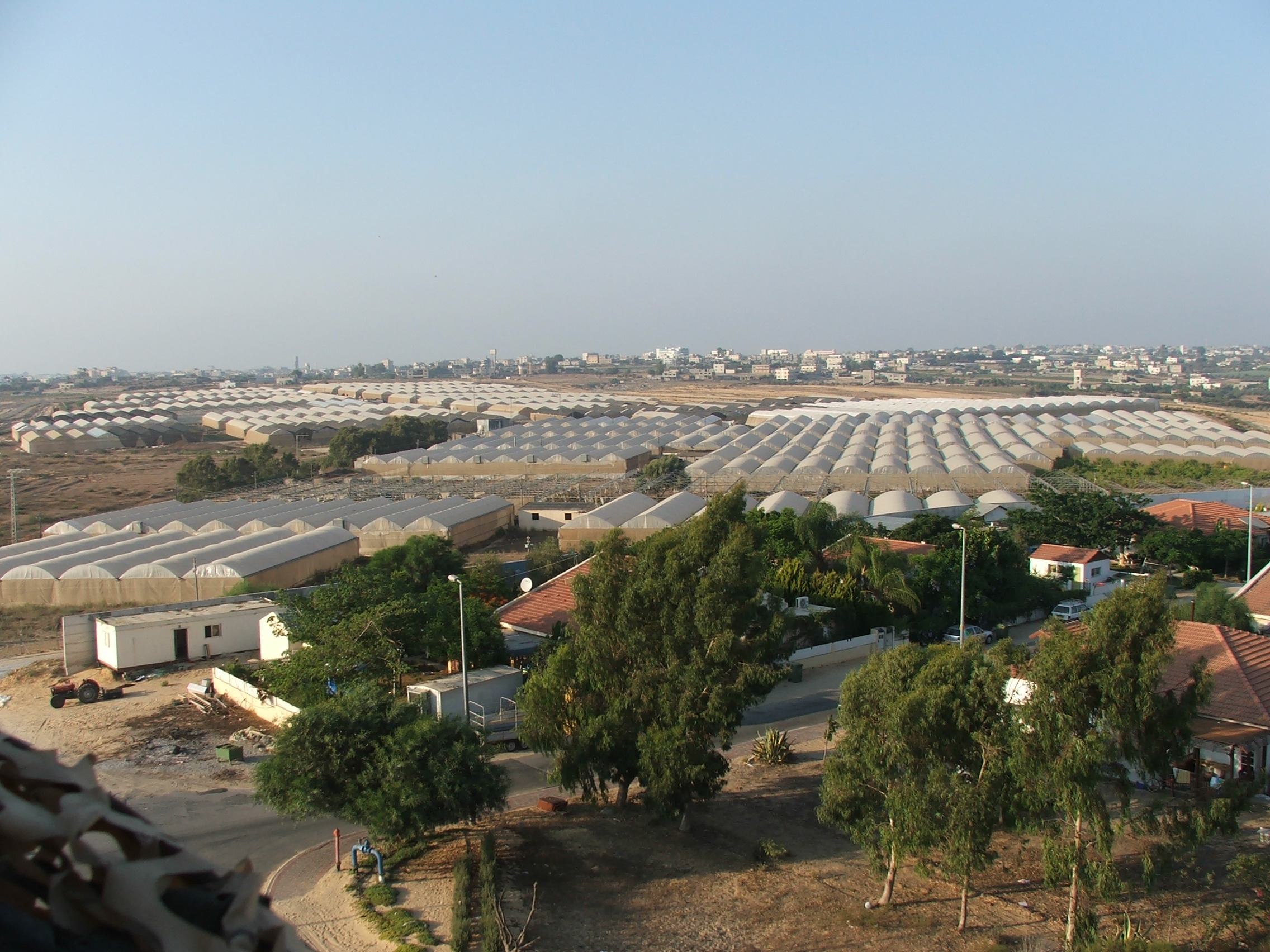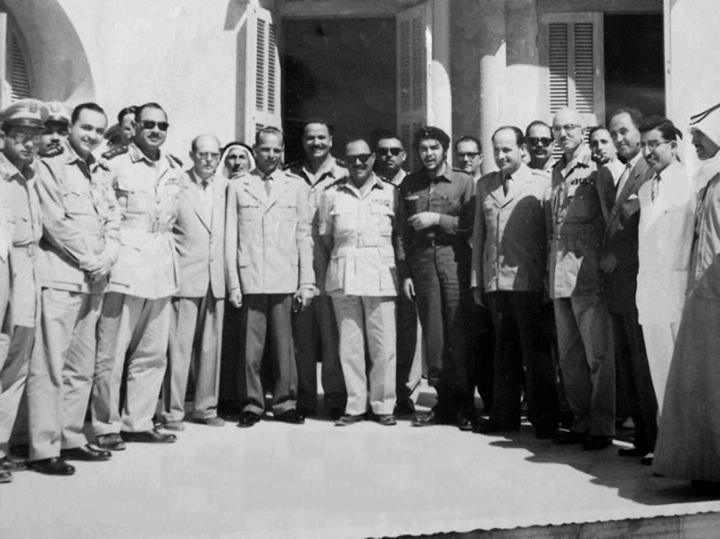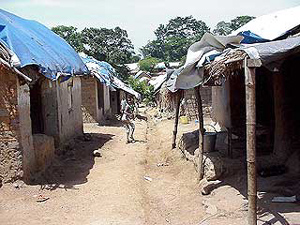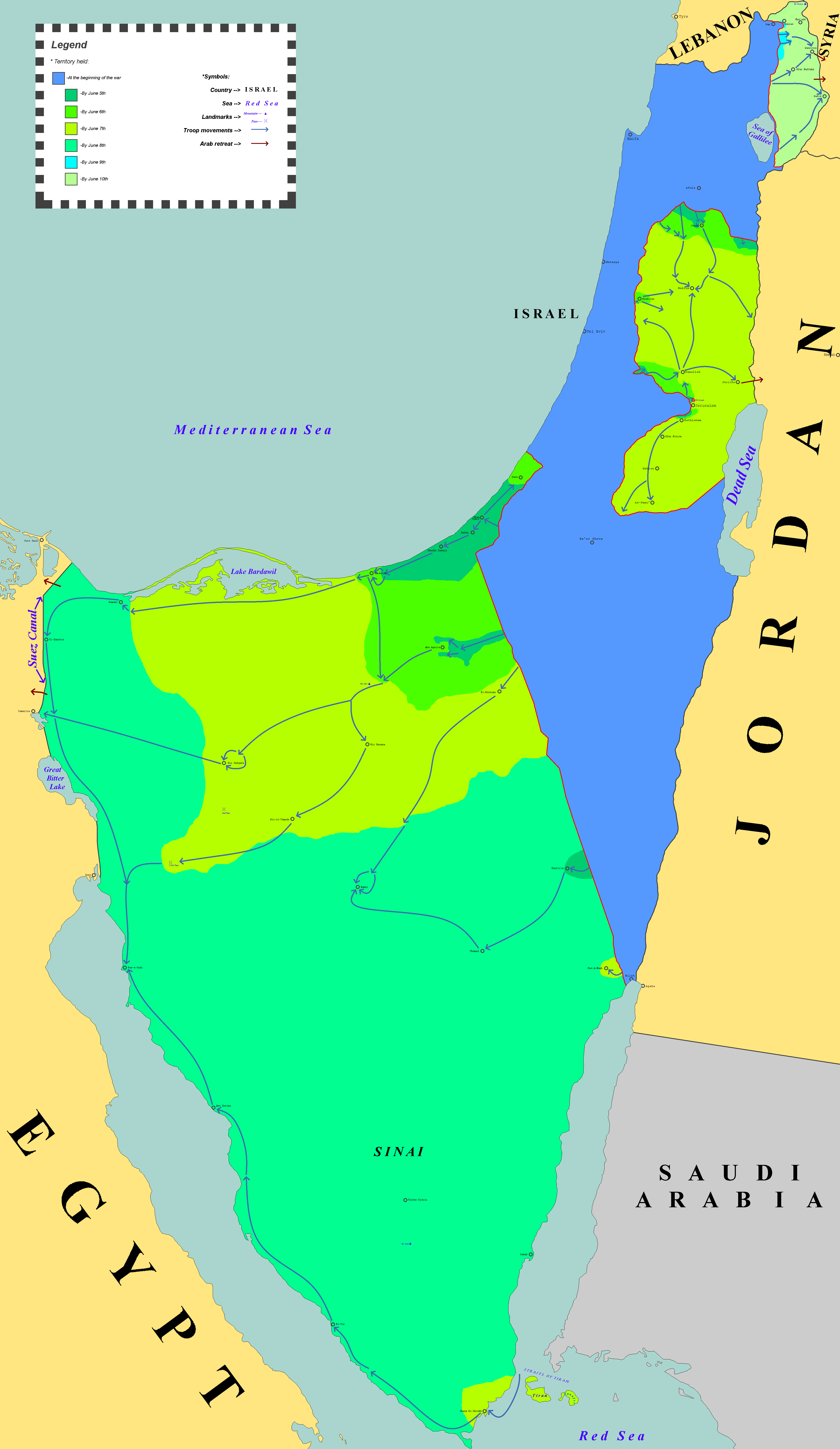|
Netzarim
Netzarim () was an Israeli settlement in the Gaza Strip about 5 kilometers southwest of Gaza City. It was established in 1972. In August 2005, the inhabitants of Netzarim were evicted by the Israel Defense Forces (IDF) as part of Israel's unilateral disengagement plan. History It was initially established in 1972 as a military base on the outskirts of Gaza City. It began as a secular Nahal (Young Pioneer) outpost of the Hashomer Hatzair movement; in 1984 it became an orthodox kibbutz. A few years later, the residents decided to change from a kibbutz to a village. It was often referred to in the media as a stronghold for Religious Zionism. Its activities included a mango plantation and vineyard, hothouse cultivated yams and cherry tomatoes, and a prestigious etrog plantation. The settlement had day care centers, kindergartens, a primary school, a kollel, a Yeshiva, and the Jews of Gaza Heritage Institute, which documented Jewish settlement in Gaza over the generations ... [...More Info...] [...Related Items...] OR: [Wikipedia] [Google] [Baidu] |
Israel's Unilateral Disengagement Plan
In 2005, Israel disengaged from the Gaza Strip by dismantling all 21 Israeli settlement, Israeli settlements there. As part of this process, four Israeli settlements in the West Bank were dismantled as well. The disengagement was executed unilaterally: Israeli authorities did not coordinate with the Palestinian National Authority (PNA) to facilitate an orderly transfer of administrative power following the withdrawal of the Israel Defense Forces (IDF) from the Gaza Strip. Since then, the United Nations, many other international humanitarian and legal organizations, and most academic commentators have continued to regard the Gaza Strip as being under Israeli-occupied territories, Israeli occupation due to Blockade of the Gaza Strip, Israel's active control over the territory's external affairs, as affirmed by the ICJ case on Israel's occupation of the Palestinian territories, 2024 International Court of Justice advisory opinion.* * Historically, according to Article 42 of the Ha ... [...More Info...] [...Related Items...] OR: [Wikipedia] [Google] [Baidu] |
Gush Katif
Gush Katif () was a bloc of 17 Israeli settlements in the southern Gaza Strip. In August 2005, the Israel Defense Forces removed the 8,600 Israeli residents from their homes after a decision from the Cabinet of Israel. The communities were demolished as part of Israel's unilateral disengagement plan, Israel's unilateral disengagement from Gaza. Geography Gush Katif was on the southwestern edge of the Gaza Strip, bordered on the southwest by Rafah and the Egyptian border, on the east by Khan Yunis, on the northeast by Deir el-Balah, and on the west and northwest by the Mediterranean Sea. A narrow, one kilometer strip of land populated by Bedouins known as al-Mawasi lay along the Mediterranean coast. Most of Gush Katif was on sand dunes that separate the coastal plain from the sea along much of the southeastern Mediterranean. Two roads served Gush Katif: Road 230, which runs from the southwest along the sea from the Egyptian border at Rafiah Yam through Kfar Yam to Tel Katif ... [...More Info...] [...Related Items...] OR: [Wikipedia] [Google] [Baidu] |
Yevul
Yevul () is a moshav in southern Israel. Located in the Hevel Shalom area of the north-western Negev desert near the Gaza Strip–Egypt border, it falls under the jurisdiction of Eshkol Regional Council. In it had a population of . History The village was established in 1981 by evacuees from Sinai. In 2005, three quarters of the former residents of Netzarim who were evicted from their village due to Israel's unilateral disengagement plan moved to temporary housing in Yevul while permanent housing is to be planned in the area. In the aftermath of the 2023 Hamas-led attack on Israel, evacuees from Yevul joined survivors of the massacre at Be'eri to take up temporary housing in a hostel near the Dead Sea The Dead Sea (; or ; ), also known by #Names, other names, is a landlocked salt lake bordered by Jordan to the east, the Israeli-occupied West Bank to the west and Israel to the southwest. It lies in the endorheic basin of the Jordan Rift Valle .... References {{Authority ... [...More Info...] [...Related Items...] OR: [Wikipedia] [Google] [Baidu] |
Ariel (city)
Ariel (; ) is an Israeli settlement organized as a City council (Israel), city council in the central West Bank, part of the Israeli-occupied territories, approximately east of the Green Line (Israel), Green Line and west of the Jordan border. Ariel was first established in 1978 and its population was in , composed of veteran and young Israelis, English-speaking immigrants, and immigrants from the former Soviet Union, with an additional influx of above 10,000 students from Ariel University.Ariel municipality Official website It is the fourth largest Israeli settlement in the West Bank, after Modi'in Illit, Beitar Illit, and Ma'ale Adumim. The international community considers Israeli settlements in the West Bank International law and Israeli settlements, illegal under international law, bu ... [...More Info...] [...Related Items...] OR: [Wikipedia] [Google] [Baidu] |
Israeli Settlement
Israeli settlements, also called Israeli colonies, are the civilian communities built by Israel throughout the Israeli-occupied territories. They are populated by Israeli citizens, almost exclusively of Israeli Jews, Jewish identity or ethnicity, and have been constructed on lands that Israel has militarily occupied since the Six-Day War in 1967. The international community considers International law and Israeli settlements, Israeli settlements to be illegal under international law, but Israel disputes this. In 2024, the International Court of Justice (ICJ) found in an advisory opinion that Israel's occupation was illegal and ruled that Israel had "an obligation to cease immediately all new settlement activities and to evacuate all settlers" from the occupied territories. The expansion of settlements often involves the confiscation of Palestinian land and resources, leading to displacement of Palestinian communities and creating a source of tension and conflict. Settlements a ... [...More Info...] [...Related Items...] OR: [Wikipedia] [Google] [Baidu] |
Gaza Strip
The Gaza Strip, also known simply as Gaza, is a small territory located on the eastern coast of the Mediterranean Sea; it is the smaller of the two Palestinian territories, the other being the West Bank, that make up the State of Palestine. Inhabited by mostly Palestinian refugees and their descendants, Gaza is one of the List of countries and dependencies by population density, most densely populated territories in the world. An end of 2024 estimate puts the population of the Strip at 2.1 million, which was a 6% decline from the previous year due to the Gaza war. Gaza is bordered by Egypt on the southwest and Israel on the east and north. Its capital and largest city is Gaza City. The territorial boundaries were established while Gaza Administration of the Gaza Strip by Egypt, was controlled by the Kingdom of Egypt at the conclusion of the 1948 Arab–Israeli war. During that period the All-Palestine Protectorate, also known as All-Palestine, was established with limited reco ... [...More Info...] [...Related Items...] OR: [Wikipedia] [Google] [Baidu] |
Refugee Camp
A refugee camp is a temporary Human settlement, settlement built to receive refugees and people in refugee-like situations. Refugee camps usually accommodate displaced people who have fled their home country, but camps are also made for internally displaced people. Usually, refugees seek Right of asylum, asylum after they have escaped war in their home countries, but some camps also house environmental migrant, environmental and economic migrants. Camps with over a hundred thousand people are common, but as of 2012, the average-sized camp housed around 11,400. They are usually built and run by a government, the United Nations, international organizations (such as the International Committee of the Red Cross), or non-governmental organization. Unofficial refugee camps, such as Idomeni in Greece or the Calais jungle in France, are where refugees are largely left without the support of governments or international organizations. Refugee camps generally develop in an impromptu ... [...More Info...] [...Related Items...] OR: [Wikipedia] [Google] [Baidu] |
West Bank
The West Bank is located on the western bank of the Jordan River and is the larger of the two Palestinian territories (the other being the Gaza Strip) that make up the State of Palestine. A landlocked territory near the coast of the Mediterranean Sea in the Levant region of West Asia, it is bordered by Jordan and the Dead Sea to the east and by Israel (via the Green Line (Israel), Green Line) to the south, west, and north. Since 1967, the territory has been under Israeli occupation of the West Bank, Israeli occupation, which has been Legality of the Israeli occupation of Palestine, regarded illegal under the law of the international community. The territory first emerged in the wake of the 1948 Arab–Israeli War as a region occupied and subsequently Jordanian annexation of the West Bank, annexed by Jordan. Jordan ruled the territory until the 1967 Six-Day War, when it was occupied by Israel. Since then, Israeli Civil Administration, Israel has administered the West Bank (ex ... [...More Info...] [...Related Items...] OR: [Wikipedia] [Google] [Baidu] |
College Of Judea And Samaria
Ariel University (), previously a public college known as the Ariel University Center of Samaria, is an Israeli university located in the urban Israeli settlement of Ariel in the West Bank. The college preceding the establishment of Ariel University was founded in 1982 as a regional branch of Bar-Ilan University. Originally located in the settlement of Kedumim, it moved to Ariel where it built a larger campus and went on to become the largest Israeli public college. In the 2004–05 academic year, the affiliation with Bar-Ilan ended and it became an independent college. On 17 July 2012, the Council for Higher Education in Judea and Samaria voted to grant the institution full university status. This move was praised by the Prime Minister Benjamin Netanyahu, Minister of Education Gideon Saar, Foreign Minister Avigdor Lieberman and some Knesset members as well as Nobel Prize in Economics winning mathematician Robert Aumann. The Council of presidents of Israeli Universities cond ... [...More Info...] [...Related Items...] OR: [Wikipedia] [Google] [Baidu] |
Six-Day War
The Six-Day War, also known as the June War, 1967 Arab–Israeli War or Third Arab–Israeli War, was fought between Israel and a coalition of Arab world, Arab states, primarily United Arab Republic, Egypt, Syria, and Jordan from 5 to 10June 1967. Military hostilities broke out amid poor relations between Israel and its Arab neighbors, which had been observing the 1949 Armistice Agreements signed at the end of the 1948 Arab–Israeli War, First Arab–Israeli War. In 1956, regional tensions over the Straits of Tiran (giving access to Eilat, a port on the southeast tip of Israel) escalated in what became known as the Suez Crisis, when Israel invaded Egypt over the Israeli passage through the Suez Canal and Straits of Tiran, Egyptian closure of maritime passageways to Israeli shipping, ultimately resulting in the re-opening of the Straits of Tiran to Israel as well as the deployment of the United Nations Emergency Force (UNEF) along the Borders of Israel#Border with Egypt, Egypt ... [...More Info...] [...Related Items...] OR: [Wikipedia] [Google] [Baidu] |
Ariel Sharon
Ariel Sharon ( ; also known by his diminutive Arik, ; 26 February 192811 January 2014) was an Israeli general and politician who served as the prime minister of Israel from March 2001 until April 2006. Born in Kfar Malal in Mandatory Palestine to Russian Jewish immigrants, he rose in the ranks of the Israel Defense Forces, Israeli Army from its creation in 1948, participating in the 1948 Palestine war as platoon commander of the Alexandroni Brigade and taking part in several battles. Sharon became an instrumental figure in the creation of Unit 101 and the reprisal operations, including the 1953 Qibya massacre, as well as in the 1956 Suez Crisis, the Six-Day War of 1967, the War of Attrition, and the Yom Kippur War, Yom-Kippur War of 1973. Yitzhak Rabin called Sharon "the greatest field commander in our history"."Israel's Man of War", Michael Kramer, ''New York'', pp. 19–24, 9 August 1982: "the "greatest field commander in our history," says Yitzak Rabin" Upon leaving the mili ... [...More Info...] [...Related Items...] OR: [Wikipedia] [Google] [Baidu] |
Al-Aqsa Intifada
The Second Intifada (; ), also known as the Al-Aqsa Intifada, was a major uprising by Palestinians against Israel and its occupation from 2000. Starting as a civilian uprising in Jerusalem and Israel proper, Israeli security responded with extreme violence, killing over 100 Palestinian protesters within the first few weeks. This led to the uprising devolving into a period of heightened violence in Palestine and Israel. This violence, including shooting attacks, suicide bombings, and military operations continued until the Sharm el-Sheikh Summit of 2005, which ended hostilities. The general triggers for the unrest are speculated to have been centered on the failure of the 2000 Camp David Summit, which was expected to reach a final agreement on the Israeli–Palestinian peace process in July 2000. An uptick in violent incidents started in September 2000, after Israeli politician Ariel Sharon made a provocative visit to the Temple Mount; the visit itself was peaceful, but, a ... [...More Info...] [...Related Items...] OR: [Wikipedia] [Google] [Baidu] |









